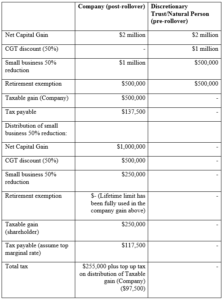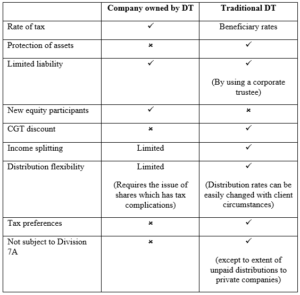
Australia has numerous industry codes and laws governing franchising. Industry codes are sets of enforceable rules and measures regulating the conduct of that industry. Franchising is regulated by the Franchising Code of Conduct (Code), together with the Australian Consumer Law (ACL).
The Australian Competition and Consumer Commission (ACCC) is the nation’s competition and consumer watchdog. A compliance and enforcement priority of the ACCC for 2018 is the protection of small businesses in relation to unfair terms in business contracts. Franchisor-compliance with the Code and the ACL is on the forefront of the ACCC’s radar.
With this ACCC focus, it is important that franchisors review and audit their standard template franchise agreements to ensure full compliance, if they have not already done so. Of particular note is the business-to-business unfair contract terms regime under the ACL.
Franchisors should remember that the ACCC can require franchisors to provide to the ACCC documents which the franchisor is obligated to generate or keep under the Code, which include franchise agreements and disclosure documents.
The Unfair Contract Terms Regime and Franchise Agreements
Generally, franchise agreements are likely to be caught by the unfair contract terms regime because they are usually:
- standard form (with little opportunity to negotiate the terms); and
- for the supply of goods or services; and
- entered into with a franchisee who meets the criteria of a ‘small business’ under the ACL; and
- have an ‘upfront price’ payable to the franchisor of under $300,000 for an agreement less than 12 months in length, or $1,000,000 if over 12 months. Upfront price includes payments, fees and charges payable over the life of the agreement, which would include both the initial franchise fee payable when signing the franchise agreement and ongoing franchise or royalty fees payable for the duration of the agreement.
Importantly to note, the unfair contracts regime only applies to contracts entered into or renewed from 12 November 2016. It will not apply to a franchise agreement entered into before this time.
As many new and renewed franchise agreements will commonly be subject to the unfair contracts regime, ensuring a franchise agreement does not contain ‘unfair’ contract terms is essential.
What is an ‘Unfair Contract Term’?
A term in a contract will be considered unfair if it satisfies all the criteria set out in section 24 of the ACL. These criteria are:
- the term would cause significant imbalance between the rights and obligations of the parties to the contract; and
- the term is not reasonably necessary to protect the legitimate interests of the stronger party who would be advantaged by the term; and
- if the term were to be relied on or used it would cause detriment (whether financial or otherwise) to the weaker party.
The term is also more likely to be considered unfair if it is not transparent, meaning the term is not expressed in plain language, is illegible, not clearly presented and not readily available to the other contracting party.
Which Types of Terms in Franchise Agreements may be Unfair?
The ACCC has noted the following as terms often found in franchise agreements that the ACCC may consider to be unfair:
- Termination clauses that are unreasonably broad or unjust. For example, the ability to terminate the agreement in circumstances where the franchisee has not committed a breach of the franchise agreement.
- Restraint clauses which apply when the franchise agreement ends. Of note will be the period of the restraint, the types of business the franchisee can be involved in, the conduct the franchisee is restrained from engaging in and the geographic area of the restraint. These will be considered unfair if the restraint goes beyond protecting the legitimate business interests of the franchisor. The wider the restraint, the more likely it is to be unfair.
- Liquidated damages clauses that do not represent a genuine pre-estimate of loss for the franchisor if a franchisee defaults and the franchise agreement is terminated early. Liquidated damages are a set amount of money payable as damages to another party upon the happening of a certain event.
- Clauses allowing the franchisor to unilaterally vary the terms of the franchise agreement without needing the mutual consent of the franchisee. Notably, franchise agreements often permit a franchisor to update their operations manual from time to time, with franchisees being obligated to comply with the change. The ACCC have been critical of franchisors who attempt to implement major changes to the obligations of franchisees by making those changes to the operations manual, rather than varying the franchise agreement. Therefore, requiring franchisees to comply with the franchisor’s unilateral changes to an operations manual may also amount to an unfair contract term where the elements of the ACL’s unfair contract term regime are met.
What are the Consequences of having an Unfair Contract Term?
The party who is disadvantaged by the unfair term (for example, the franchisee) can bring court proceedings against the party advantaged by that term (for example, the franchisor), and ask the court to make a decision about whether the term is unfair.
Alternatively, the ACCC can bring proceedings directly against the party who is advantaged by the unfair term.
If a court declares a term in a contract to be ‘unfair’ then that term will be void and unenforceable. If this occurs, that clause will be severed and the remainder of the contract will continue to operate without that unfair contract term.
For example, if a court held that a provision which entitled the franchisor to terminate the franchise agreement without a reason to be unenforceable, then the remainder of the franchise agreement would still stay in force. If the franchisor wished to terminate the franchise agreement, they would need to rely on the remaining provisions governing termination (such as first giving the franchisee notice of breach and a reasonable opportunity to remedy the breach).
Just because a franchise agreement contains a term which may fit the criteria of an ‘unfair’ term does not mean that term is automatically unenforceable. It must be declared to be unenforceable by a court.
Will an Unfair Contract Term contravene the Code?
At the time of writing this article in September 2018, major players in the Australian franchising industry are campaigning for amendments to the Code which would prohibit a franchise agreement from containing an unfair contract term. Rouse Lawyers will be following these developments closely and publishing further updates if such changes are implemented.
Franchisors should also be mindful of the obligation under the Code to act in good faith. If a franchisor acts outside of their own legitimate business interests and attempts to enforce a term in a franchise agreement meeting the criteria of an unfair contract term, the franchisor may alternatively be failing to act in good faith.
What does this mean from a practical perspective?
For the franchisor wishing to take advantage of the unfair term and use that term to the detriment of the franchisee, this means that the unfair term has the potential to be unenforceable while in all likelihood the remainder of the franchise agreement will continue to operate. Consequently, the practical result of having a clause declared unfair and unenforceable could be exposure to risk or the loss of a right under the franchise agreement.
By way of another example, if an indemnity clause in favour of the franchisor is too broad and goes beyond the necessary protection of the franchisor, it may be declared unfair. This may result in the entire indemnity clause being unenforceable, meaning that the franchisor loses the protection of being indemnified for the remaining time left on the franchise agreement. If, on the other hand, the indemnity clause was reasonable and not unfair, the franchisor would continue to have the benefit of protection under the indemnity clause.
Franchising Code of Conduct and Franchise Agreements
The Code also sets out requirements regarding items that must or must not be included in a franchise agreement.
What are the Requirements of the Franchising Code of Code?
Some of the rules the Code contains about such clauses include:
- Franchise agreements must not require franchisees to sign a ‘general’ release from liability in favour of the franchisor or require a franchisee to sign a waiver of any written or verbal representation made by the franchisor. This means the franchise agreement cannot say that a franchisor is relieved from liability if they act negligently, and cannot say that promises made by the franchisor before the franchise agreement was signed are unenforceable. If either of these are contained in the franchise agreement they will be unenforceable regardless of whether the franchise agreement is signed by the franchisee.
- A dispute resolution clause must not require mediation of a dispute to be conducted outside of Australia, or in a state or territory in which the franchised business is not based. This means that if the franchisee operates their business in Brisbane, then the franchisor cannot force the franchisee to attend a mediation at the franchisor’s head office in Sydney. Additionally, a clause cannot require an action or proceeding to be commenced outside of Australia, or in a state or territory in which the franchised business is not based. This means that if the franchisee operates their business in Queensland, then legal proceedings must be bought in Queensland. If such contravening clauses do exist they will be unenforceable and have no effect.
- A franchise agreement must not include a clause requiring the franchisee to pay for the franchisor’s costs of settling a dispute under a franchise agreement. Such a clause will have no effect.
It is also prudent to ensure the requirements of the Code are reflected in the franchise agreement. By way of example:
- A franchisor cannot unreasonably withhold consent to the transfer of a franchisee’s business.
- If it’s a new franchise agreement and not a renewal or a transfer, then the franchisee is entitled to a 7 day cooling off period.
- There are certain circumstances under the Code which entitle a franchisor to terminate a franchise agreement immediately, for example, a franchisee’s fraudulent behavior or certain events of insolvency. A franchisor can only rely on these circumstances to terminate a franchise agreement if the franchise agreement expressly contains a provision affording this right.
Reflecting these things in the franchise agreement can assist a franchisor avoid inadvertent non-compliance with the Code.
What are the Consequences of Non-compliance with Franchising Code of Conduct?
The consequences for non-compliance with the Code vary depending on the contravention. As noted, the inclusion of particular clauses in a franchise agreement, such as requiring franchisees to pay the franchisor’s legal costs of a dispute, results in that clause having no effect. Other contraventions may attract a court ordered financial penalty and undertakings (which can apply to both a company and its directors). A court ordered undertaking may include, for example, providing a notice on the franchisor’s website outlining the contravention and the steps consumers can take if they are affected by the contravention.
An alternative (or sometimes an addition) to court ordered financial penalties are ACCC issued infringement notices, penalties and undertakings. Breaches of some provisions of the Code will attract penalties of up to $63,000 in each instance, and these breaches may lead to infringement notices for $10,500 per breach. The values of these penalties are currently under review and are likely to increase.
Takeaways
Franchisors should consider whether their franchise agreement contains unfair contract terms and whether it fully complies with the Code. It is prudent for franchisors to have their franchise agreement reviewed by a specialist franchising lawyer.
It is also important for franchisees to be conscious as to whether their franchisor is complying with the Code, and that certain provisions in their franchise agreement have the potential to be unfair and unenforceable. Taking the time to consider this will assist franchisees to manage their business with more certainty.
There may still be freedom for franchisors to have a franchise agreement containing whatever terms they want, but there will not be freedom to enforce those terms if they are unfair or contravene the Code.
The post Is Your Franchise Agreement Unfair? appeared first on Rouse Lawyers.
















